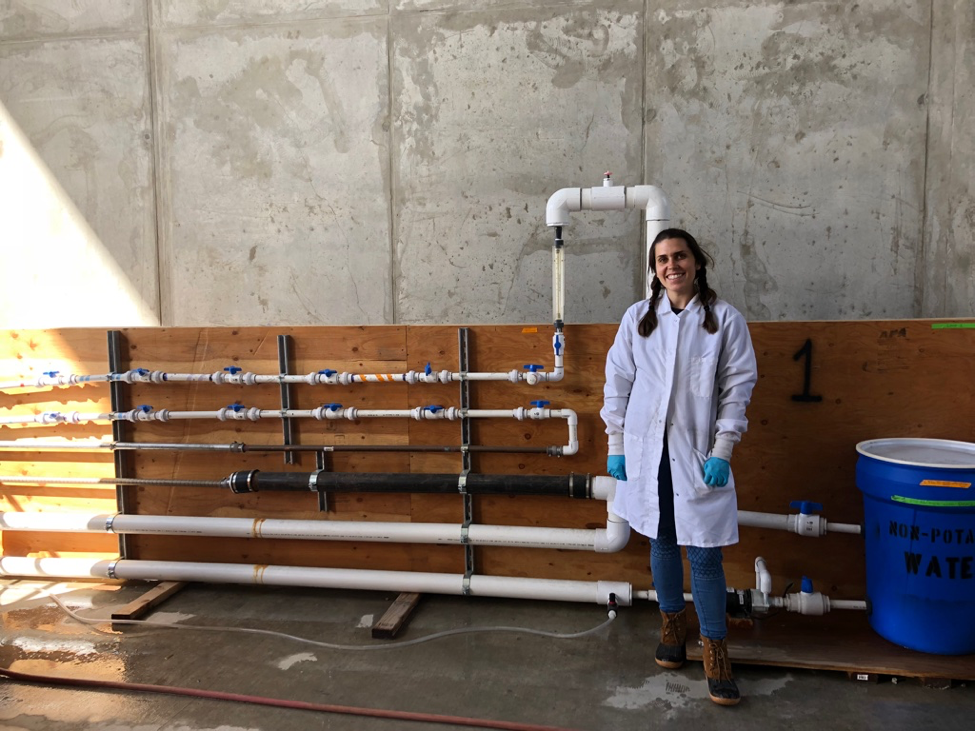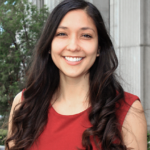The Berkeley Water Center is host to many student scholars who are passionate about their water research and making the work a better place. Get to know our students, their research and what we do at the Berkeley Water Center.
Lauren Kennedy

Name: Lauren Kennedy
Advisor: Kara Nelson
Department: Civil and Environmental Engineering
WHERE DID YOU DO YOUR UNDERGRAD/MASTERS AND WHY DID YOU CHOOSE UC BERKELEY?
I received my Bachelor’s degree from Purdue University in Environmental and Ecological Engineering. During that process, I completed research in atmospheric chemistry, materials engineering, and water chemistry. Those experiences helped me realize that I wanted to go to graduate school, that I wanted to find a collaborative lab group, and that I was still unsure of the research topic I wanted to pursue. When I visited UC Berkeley, I met current graduate students who I could picture myself working with and I learned more about research in Kara’s lab that interested me, which ultimately led to my decision. I then received my Master’s from UC Berkeley.
WHAT KIND OF RESEARCH GETS YOU UP IN THE MORNING?
I am excited about research that is intellectually stimulating but also applied. If I feel like what I am doing is a puzzle with a solution that could benefit people, I am up and ready to start thinking!
IF YOU COULD MAKE A GROUNDBREAKING DISCOVERY OR CHANGE A SYSTEM IN THE WORLD OF WATER RESEARCH, WHAT WOULD IT BE?
Since around April 2020, I have been working on the COVID-19 wastewater-based epidemiology for the bay area (Covid-WEB) project. The Covid-WEB pop-up laboratory is monitoring wastewater from around the San Francisco Bay Area to track SARS-CoV-2 in the contributing population. Monitoring SARS-CoV-2 in wastewater may facilitate public health response to COVID-19 outbreaks potentially by providing early warning of outbreaks compared to clinical incidence data and by providing insight into asymptomatic and symptomatic cases. However, both the methodological research for and the application of this method have been occurring simultaneously, and more research and development can make the results even more useful to public health officials. I think it would help to discover exactly how the signal we see in wastewater relates to the true COVID-19 prevalence or incidence and how to account for background noise that can obscure the signal. Many researchers are investigating these questions now, and we seem to gain more clarity each day!
WHAT’S THE MOST EXCITING CHALLENGE YOU’VE TACKLED WHILE STUDYING AT UC BERKELEY?
The most exciting challenge I have tackled was figuring out how to simulate a direct potable reuse drinking water distribution system. I helped design pipe loop rigs that could circulate 100 L of water and could also be sampled for biofilm. As part of this team, I learned that simulating a treated drinking water augmentation system successfully is challenging, but we learned a lot from this process that we are hoping to detail in a publication soon to help others design similar experiments.
WHERE DO YOU SEE YOURSELF IN 10 YEARS?
I see myself still involved in research and potentially with my own research group. If I stay in academia, I aspire to be challenging the status quo and both learning from and serving as a mentor to students, particularly others figuring out the world of higher education and academia as they progress!
Dana Hernandez

Name: Dana Hernandez
Department: Civil and Environmental Engineering
Advisor: Ashok Gadgil
WHERE DID YOU DO YOUR UNDERGRAD/MASTERS AND WHY DID YOU CHOOSE UC BERKELEY?
I did my undergrad in Civil and Environmental Engineering at UC Irvine and my master’s here at UC Berkeley. One of the main reasons I chose UC Berkeley was the graduate students that I met during Visit Day. I became really excited when they presented lightning talks on their research projects! It was really motivating to learn about the large global problems that were being tackled, and I wanted to be part of these efforts for positive social impact.
WHAT KIND OF RESEARCH GETS YOU UP IN THE MORNING?
During my PhD I’ve had the opportunity to be involved in different phases of technology development and deployment. While in India I learned just how important it is to form strong academic, industry, and community partnerships for successful field piloting of the ECAR (Electro-Chemical Arsenic Remediation) plant. Together we were able to provide arsenic-safe drinking water. This type of multidisciplinary and collaborative research is what I find so exciting.
IF YOU COULD MAKE A GROUNDBREAKING DISCOVERY OR CHANGE A SYSTEM IN THE WORLD OF WATER RESEARCH, WHAT WOULD IT BE?
Naturally occurring arsenic in groundwater is a global problem that exists here in California. Not just a public health problem, it’s an environmental justice issue that impacts mostly poor, Latinx and African American communities in the Central Valley. Current arsenic removal technologies are too expensive and costly to be maintained in the affected small water systems. More work is needed on developing and implementing an affordable, robust and sustainable water treatment system with low maintenance requirements, and engaging local community members early on in the technology deployment process.
WHAT’S THE MOST EXCITING CHALLENGE YOU’VE TACKLED WHILE STUDYING AT UC BERKELEY?
In the Gadgil lab we have been working on a next-generation ECAR system specific to the California context. An exciting challenge has been working together with researchers from the School of Public Health and with community members of the Central Valley on the arsenic problem in rural California. I’ve been able to apply some of the lessons learned while in India, but with the different constraints in California the solution will look different as well. With the many components of the projects including the social, economic and technical, I think in our team we learn a lot from each other, build on each other’s work, and focus on various aspects. Lately I’ve been working mostly in the lab so I’m currently excited about learning synchrotron-based characterization methods to analyze the local bonding environment of the electrolytically generated iron precipitates.
WHERE DO YOU SEE YOURSELF IN 10 YEARS?
I’m not sure where in the world I’ll be, but I hope to stay in academia continuing to learn and grow as a researcher and working on removal of toxic contaminants from drinking water sources. It would be awesome to be part of a multidisciplinary and collaborative hub focused on solving public health and environmental justice problems.
Chris Hyun

Chris Hyun is a doctoral candidate in the Energy and Resources Group who is passionate about equitable access to drinking water and sanitation. Get to know more about him and his research!
Aidan Cecchetti
 Aidan Cecchetti is a Civil and Environmental Engineering doctoral student who is passionate about getting out in the field to do research. Get to know more about him!
Aidan Cecchetti is a Civil and Environmental Engineering doctoral student who is passionate about getting out in the field to do research. Get to know more about him!
Kyle Leathers
 Kyle Leathers is an Environmental Science, Policy, and Management doctoral student who is leading an experiment on the effects of climate change on stream food webs in the Sierra Nevada. Get to know more about him and his research!
Kyle Leathers is an Environmental Science, Policy, and Management doctoral student who is leading an experiment on the effects of climate change on stream food webs in the Sierra Nevada. Get to know more about him and his research!
Sara Glade
 Sara Glade is a Civil and Environmental Engineering doctoral student who is passionate about improving access to safe drinking water. Get to know more about her and her research!
Sara Glade is a Civil and Environmental Engineering doctoral student who is passionate about improving access to safe drinking water. Get to know more about her and her research!
Scott Miller
 Scott Miller is a Civil and Environmental Engineering doctoral candidate who is looking at the groundbreaking treatment of wastewater and putting it back into distribution. Get to know more about him and his research!
Scott Miller is a Civil and Environmental Engineering doctoral candidate who is looking at the groundbreaking treatment of wastewater and putting it back into distribution. Get to know more about him and his research!
